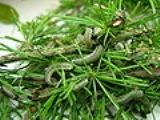
Larch sawfly
Encyclopedia
The larch sawfly is a species of sawfly
. The adult sawfly resembles a black wasp
, is about ½ inch in length with a thick waist and has brown to orangish markings on the abdomen. Larvae have black heads, gray-green bodies with white undersides, and are about 15–18 mm long when full grown. Larvae occur in groups and characteristically curl their bodies upward in a "J" shape when disturbed.
In the spring when larch trees
are leafed out and the new growth is expanding, the female sawfly can be seen depositing eggs in new shoots near the branch tips.
Most trees are very tolerant of defoliation and trees generally recover during the summer, however severe defoliation over several years can weaken the trees causing them to be less likely to survive a harsh winter.
Sawfly
Sawfly is the common name for insects belonging to suborder Symphyta of the order Hymenoptera. Sawflies are distinguishable from most other Hymenoptera by the broad connection between the abdomen and the thorax, and by their caterpillar-like larvae...
. The adult sawfly resembles a black wasp
Wasp
The term wasp is typically defined as any insect of the order Hymenoptera and suborder Apocrita that is neither a bee nor an ant. Almost every pest insect species has at least one wasp species that preys upon it or parasitizes it, making wasps critically important in natural control of their...
, is about ½ inch in length with a thick waist and has brown to orangish markings on the abdomen. Larvae have black heads, gray-green bodies with white undersides, and are about 15–18 mm long when full grown. Larvae occur in groups and characteristically curl their bodies upward in a "J" shape when disturbed.
In the spring when larch trees
Larch
Larches are conifers in the genus Larix, in the family Pinaceae. Growing from 15 to 50m tall, they are native to much of the cooler temperate northern hemisphere, on lowlands in the north and high on mountains further south...
are leafed out and the new growth is expanding, the female sawfly can be seen depositing eggs in new shoots near the branch tips.
Damage symptoms
Egg-laying causes shoots to curl as they grow. Larvae occur in groups or clumps and are very obvious when present. Defoliation is rarely complete but trees can appear very thin crowned.Most trees are very tolerant of defoliation and trees generally recover during the summer, however severe defoliation over several years can weaken the trees causing them to be less likely to survive a harsh winter.

